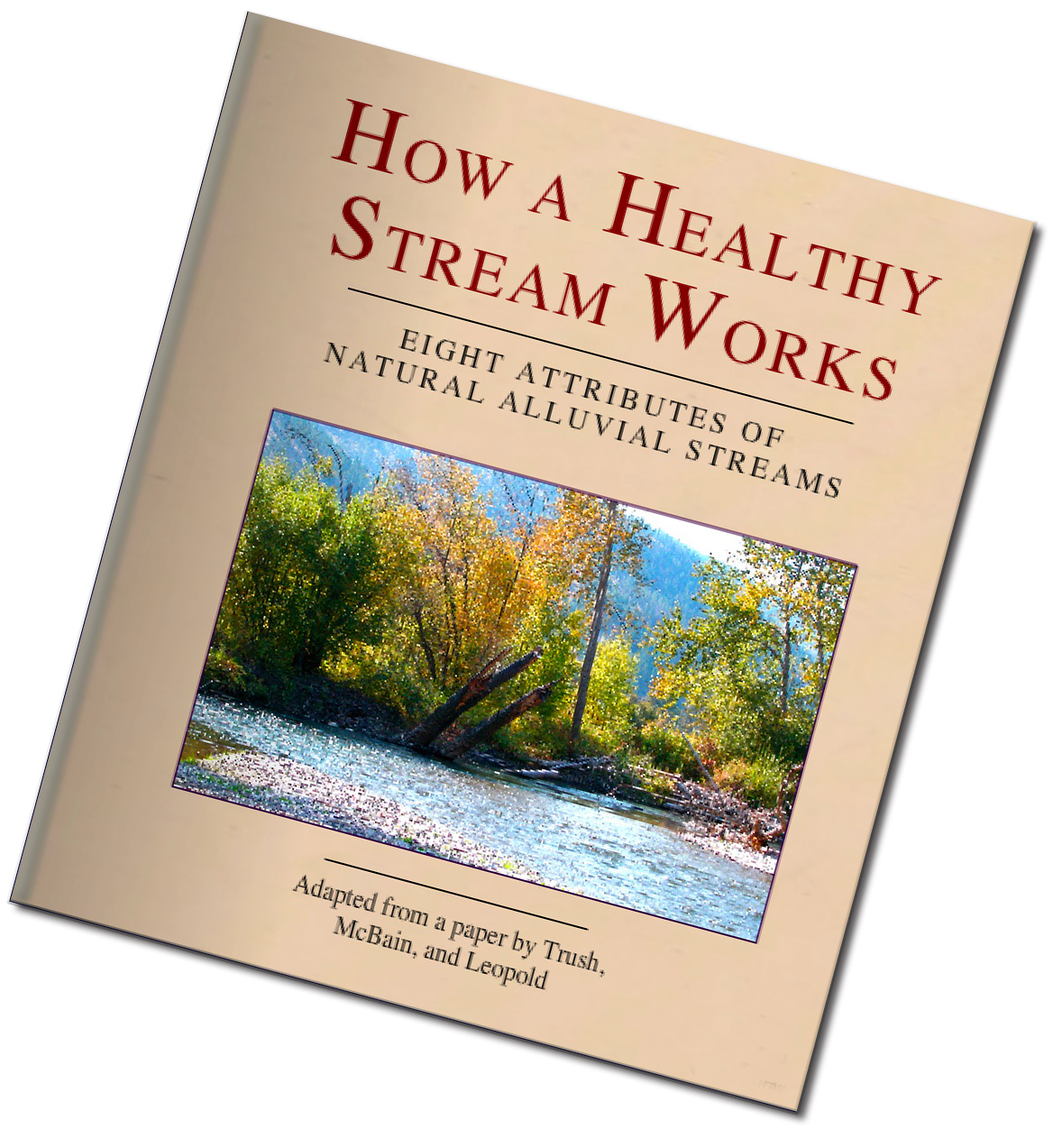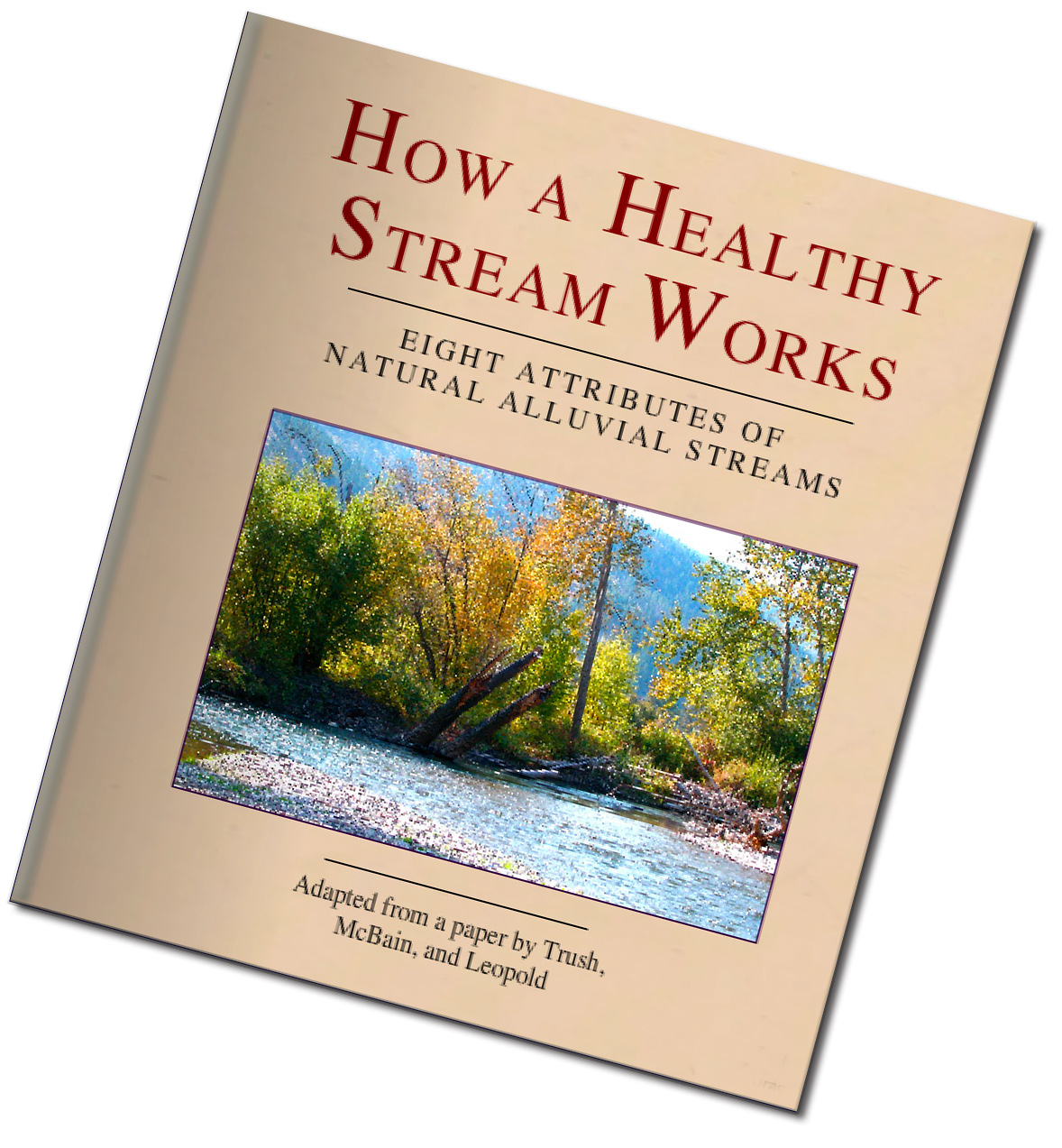Hydrology: Attributes of a Healthy Stream
An alluvial stream is one whose channel is composed of the sediments transported by the stream itself and that generally changes the shape of its bed as the rate of flow changes. (Adapted from Attributes of an alluvial river and their relation to water policy and management by Trash, McBain, and Leopold).

Attribute Five: The Sediment Entering is Balanced with the Sediment Leaving
Over many years, the amount and size of sediment moving into a stream equals the amount and size of sediment moving out. Periodic flood flows are critical to maintaining this balance.
When the balance is upset, the stream either erodes or begins filling in, depending on which way the scales are tipped.
Chronic channel erosion (or degradation) indicates either that (1) less sediment is coming in than is leaving or (2) the sediment size has decreased.
Chronic stream filling (a process called aggradation) indicates either that (1) more sediment is coming in than is leaving or (2) the sediment size has increased.
Click on one of the buttons at right to see what happens to the stream channel when the sediment balance changes.
- When more sediment enters a stream than is leaving it, the stream responds by filling in.
- When less sediment enters, the stream erodes.
- When sediment size increases, the stream responds by filling in.
- When sediment size decreases, the stream erodes.
Over many years, the amount and size of sediment moving into a stream equals the amount and size of sediment moving out. Click the buttons to see how changes in sediment input affects the stream.
Hydrology: Attributes of a Healthy Stream
An alluvial stream is one whose channel is composed of the sediments transported by the stream itself and that generally changes the shape of its bed as the rate of flow changes. (Adapted from Attributes of an alluvial river and their relation to water policy and management by Trash, McBain, and Leopold).

Attribute Five: The Sediment Entering is Balanced with the Sediment Leaving
Over many years, the amount and size of sediment moving into a stream equals the amount and size of sediment moving out. Periodic flood flows are critical to maintaining this balance.
When the balance is upset, the stream either erodes or begins filling in, depending on which way the scales are tipped.
Chronic channel erosion (or degradation) indicates either that (1) less sediment is coming in than is leaving or (2) the sediment size has decreased.
Chronic stream filling (a process called aggradation) indicates either that (1) more sediment is coming in than is leaving or (2) the sediment size has increased.
Click on one of the buttons at right to see what happens to the stream channel when the sediment balance changes.
- When more sediment enters a stream than is leaving it, the stream responds by filling in.
- When less sediment enters, the stream erodes.
- When sediment size increases, the stream responds by filling in.
- When sediment size decreases, the stream erodes.
Over many years, the amount and size of sediment moving into a stream equals the amount and size of sediment moving out. Click the buttons to see how changes in sediment input affects the stream.
Hydrology: Attributes of a Healthy Stream
An alluvial stream is one whose channel is composed of the sediments transported by the stream itself and that generally changes the shape of its bed as the rate of flow changes. (Adapted from Attributes of an alluvial river and their relation to water policy and management by Trash, McBain, and Leopold).
Attribute Five: The Sediment Entering is Balanced with the Sediment Leaving
Over many years, the amount and size of sediment moving into a stream equals the amount and size of sediment moving out. Click the buttons to see how changes in sediment input affects the stream.
Over many years, the amount and size of sediment moving into a stream equals the amount and size of sediment moving out. Periodic flood flows are critical to maintaining this balance.
When the balance is upset, the stream either erodes or begins filling in, depending on which way the scales are tipped.
Chronic channel erosion (or degradation) indicates either that (1) less sediment is coming in than is leaving or (2) the sediment size has decreased.
Chronic stream filling (a process called aggradation) indicates either that (1) more sediment is coming in than is leaving or (2) the sediment size has increased.
Click on one of the buttons at right to see what happens to the stream channel when the sediment balance changes.
- When more sediment enters a stream than is leaving it, the stream responds by filling in.
- When less sediment enters, the stream erodes.
- When sediment size increases, the stream responds by filling in.
- When sediment size decreases, the stream erodes.